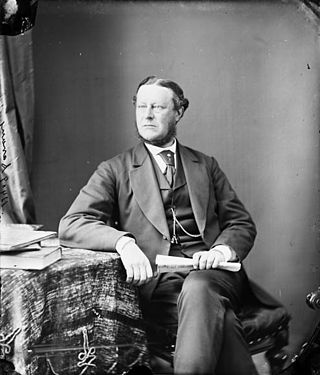Related Research Articles

Annapolis County is a county in the Canadian province of Nova Scotia located in the western part of the province located on the Bay of Fundy. The county seat is Annapolis Royal.

Middleton is a town in Annapolis County, Nova Scotia, Canada. Situated on the north bank of the Annapolis River, it is located close to the centre of the Annapolis Valley, from which it gets its nickname, "The Heart of the Valley".

Annapolis is a provincial electoral district in Nova Scotia, Canada, that elects one member of the Nova Scotia House of Assembly.

Alfred William Savary, served as a Nova Scotia member of the 1st Canadian Parliament for the Digby riding.

John Chipman Wade was a Canadian politician and lawyer who served in both the Nova Scotia House of Assembly and the House of Commons of Canada.

Erasmus James Philipps was the second longest serving member on Nova Scotia Council (1730-1760) and the nephew of Nova Scotia Governor Richard Philipps. He was also a captain in the 40th Regiment of Foot. He was a member of the Nova Scotia House of Assembly from 1759 to 1760. On the retirement of Lt. Gov. Paul Mascarene, Major Philipps became commander of the forces at Annapolis Royal, Nova Scotia (1749-1760). He arranged the Cape Sable Campaign during the French and Indian War. He is the earliest known settler of Nova Scotia who was buried in the Old Burying Ground.
Phineas Lovett was a farmer, merchant, judge and political figure in Nova Scotia. He represented Annapolis Township from 1775 to 1783 and from 1799 to 1806 and Annapolis County from 1808 to 1811 in the Nova Scotia House of Assembly.
Christopher Prince was a merchant, farmer and political figure in Nova Scotia. He represented Granville Township in the Nova Scotia House of Assembly from 1772 to 1785.

John Ritchie was a Scottish-born merchant and politician in Nova Scotia. He represented Annapolis County in the Nova Scotia House of Assembly from 1783 to 1785.
Stephen De Lancey was a lawyer and political figure in New York state and Nova Scotia. He represented Annapolis Township in the Nova Scotia House of Assembly from 1784 to 1789.
Thomas Ritchie was a lawyer, judge and political figure in Nova Scotia. He represented Annapolis County in the Nova Scotia House of Assembly from 1806 to 1824.
Cereno Upham Jones was a farmer, merchant and political figure in Nova Scotia. He represented Annapolis County in the Nova Scotia House of Assembly from 4 June 1817 to 1818.
John Robertson was a sailor, merchant and political figure in Nova Scotia. He represented Annapolis township in the Nova Scotia House of Assembly from 1820 to 1826.
Frederick Armand Robicheau was a political figure in Nova Scotia. He represented Annapolis County in the Nova Scotia House of Assembly from 1836 to 1840. Simon d'Entremont and Robicheau are believed to be the first Acadians elected to a legislative assembly in North America.
Henry Rutherford was a merchant and political figure in Nova Scotia. He represented the Digby Township from 1793 to 1806 and Annapolis County from 1806 to 1807 in the Nova Scotia House of Assembly.
Benjamin James was a farmer and political figure in Nova Scotia.
Elnathan Whitman was a farmer and political figure in Nova Scotia. He represented the township of Annapolis in the Nova Scotia House of Assembly from 1836 to 1840.
Alfred Whitman was a farmer, merchant and political figure in Nova Scotia. He represented the township of Annapolis in the Nova Scotia House of Assembly from 1844 to 1857.
John Johnston was a lawyer and political figure in Nova Scotia. He represented Annapolis County in the Nova Scotia House of Assembly from 1829 to 1836. His surname also appears as Johnstone.
Carman Kerr is a Canadian politician, who was elected to the Nova Scotia House of Assembly in the 2021 Nova Scotia general election. He represents the riding of Annapolis as a member of the Nova Scotia Liberal Party.